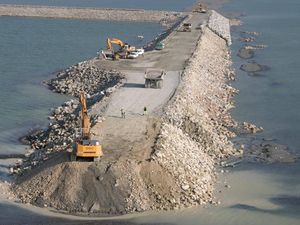Wave energy converters in coastal structures

|
Introduction
Coastal works along European coasts are composed of very diverse structures. Many coastal structures are ageing and facing problems of stability, sustainability and erosion. Moreover climate change that produces especially sea level rise represents a new danger for them. Coastal dikes will be indeed exposed in Europe to waves with height greater than the design value, in particular all the structures built in shallow water where the depth imposes the maximal amplitude because of wave breaking.
These structures need therefore to be modernized and adapted on the one hand to climate change and on the other hand to increase of maritime traffic and size of container carriers.
This necessary adaptation will be costly but will constitute an opportunity to integrate converters of sustainable energy in the new maritime structures along the coasts and in particular in harbours. This initiative will contribute to the reduction of the greenhouse effect. Produced energy can be directly used for the energy consumption in harbour area and will reduce the carbon footprint of harbours by feeding the docked ships with green energy. Nowadays these ships use their motors to produce electricity power on board even if they are docked. Integration of wave energy converters in coastal structure will favour the emergence of the new concept of future harbour with zero emission.
Wave energy and wave energy flux
In a sea state, the time-mean wave energy density E per unit horizontal area on the water surface (J/m²) is the sum of kinetic and potential energy density per unit horizontal area. The potential energy density is equal to the kinetic energy both contributing half to the time-mean wave energy density E that is proportional to the wave height squared according to linear wave theory
